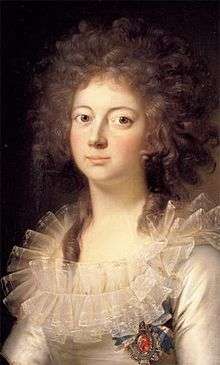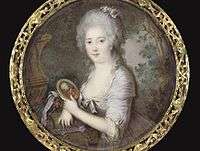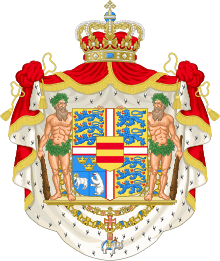Marie of Hesse-Kassel
| Marie of Hesse-Kassel | |
|---|---|
 | |
| Queen consort of Denmark | |
| Tenure | 13 March 1808–3 December 1839 |
| Coronation |
31 July 1815 Frederiksborg Palace Chapel |
| Queen consort of Norway | |
| Tenure | 13 March 1808–14 January 1814 |
| Born |
28 October 1767 Hanau |
| Died |
22 March 1852 (aged 84) Frederiksberg Palace |
| Burial | Roskilde Cathedral |
| Spouse | Frederick VI |
| Issue among others... |
Caroline, Hereditary Princess of Denmark Vilhelmine, Duchess of Schleswig-Holstein-Sonderburg-Glücksburg |
| House | House of Hesse |
| Father | Landgrave Charles of Hesse-Kassel |
| Mother | Princess Louise of Denmark |
| Religion | Lutheranism |
Marie Sophie Frederikke of Hesse-Kassel ( 28 October 1767 – 21/22 March 1852) was queen consort of Denmark and Norway. She also served as regent of Denmark in 1814–1815.
Early life

Marie was the eldest child of Landgrave Charles of Hesse-Kassel and Princess Louise of Denmark, born in Hanau. Her paternal grandparents were Frederick II of Hesse-Kassel and Princess Mary of Great Britain, a daughter of King George II and Caroline of Ansbach. Her maternal grandparents were Frederick V of Denmark and Louise of Great Britain, another daughter of George II and Caroline of Ansbach. Her father was the second son of the ruler of Hesse-Kassel, and as such, had no principality of his own. Thus he acted in such positions as were offered to cadet members of royal houses by their reigning relatives. Denmark offered more and better positions than the small Hesse-Kassel.
Marie Sophie was largely raised in Denmark, where her father held notable positions, such as the governorships of provinces. Her mother was the third and youngest daughter of King Frederick V of Denmark and his consort, Louise of Great Britain. As such, she was the niece of King Christian VII and the Prince Regent Frederick, as well as their first cousin. She spent her childhood at Gottorp Castle, were her father resided as governor, and at her mother's Danish country estate Louisenlund. She was given a German education, and German was her first language. She was affected by her father's interest in mysticism, and was also fascinated by dreams.
Crown Princess
On 31 July 1790 in Gottorp, she married her first cousin Frederick, then crown prince and regent of Denmark, who would in 1808 ascend as King Frederick VI. In the aftermath of the defeat of Denmark's ally, the French emperor Napoleon I, Denmark-Norway fell apart and the king and queen of Denmark ceased being king and queen of Norway in 1814.
Marie was selected by her cousin as his spouse mainly as a way for him to demonstrate his independence from his Court, who wanted a more political dynastic match. Frederick arranged his marriage against the will of both his court, council and also of his sister and brother-in-law, but he had the support of his future father-in-law, who attempted to gain influence in Danish state affairs through it.[1]
The marriage was greeted with great enthusiasm by the public, as she was regarded as completely Danish and not as a foreigner, and she was referred to as a daughter of the nation. Her official entrance into Copenhagen 14 September 1790 was described as a triumph. While her first language was, in fact, German, she soon learned to speak Danish.
At the royal court, however, she was overshadowed by the sister of her spouse, her sister-in-law Princess Louise Auguste of Denmark, who was a popular and celebrated beauty and the real First Lady of the court. She also endured great pressure by the demand to produce a son, which occupied her during her time as crown princess. When her last childbirth in 1808 resulted in an injury which prevented further intercourse, she was forced to accept her spouse's adultery with Frederikke Dannemand. The relationship between Marie and Frederick VI was described as a respectful friendship, and the political turmoil of the time reportedly created a trusting relationship between them.
Marie followed her spouse to Holstein in 1805, where she lived with him until he became King in 1808.
Queen
In 1808, Frederick became king, and Marie queen. On 31 October 1809, she made her second official entry to Copenhagen, this time as queen, an occasion which has been described as a moment when her personal popularity among the public was demonstrated.
Queen Marie was regent of Denmark from 5 September 1814 to 1 June 1815, during the absence of her spouse in the Vienna Congress in Austria. She managed the affairs of state very well, according to critics. In 1807-14, she wrote the Exposé de la situation politique du Danemarc, an analysis of the political condition of Denmark, which she read aloud for the council as regent on her opening speech. She excused Frederick VI in regard to the Norwegian question, and strongly criticized the behavior of Prince Christian, though she did send him a ship to evacuate him from Norway and bring him back to Denmark.
During the reign of Frederick, particularly after the end of the Napoleonic wars, the royal family became a popular symbol of family life, as the king appeared to the public in the capital walking in the park with his wife and daughters, and sailing with them along the canal.[2]
From the end of her regency until the death of Frederick VI, her life as queen was a quiet one and she participated in social life only when necessary to fulfill her representational duties. One of the reasons for her reclusive life style was reportedly the injury from her last childbirth, which evidently made it necessary for her to move about more carefully.
From 1815, she protected the women's charity organisation Det Kvindelige Velgørende Selskab. She was interested in politics, genealogy and history. In 1822–24 she published the genealogy Supplement-Tafeln zu Joh. She inspired Frederick IV to take the later Christian IX of Denmark into his family in 1825: he arrived in Denmark in 1832.[3]
Queen Dowager
Marie was widowed in 1839. As a widow, she withdrew from public life, respected as a symbol of the old dynasty. She divided her time between Fredericksborg and Amalienborg. Reportedly, she was a stranger to politics during her later life, but the strife between the branches of the family during the succession crisis and the rebellion in Holstein pained her.
Marie died at Amalienborg in 1852.
Children


Marie and Frederick VI had eight children. None of Frederick VI's sons survived infancy, however, and when he died in 1839, he was succeeded by his cousin, Christian VIII of Denmark. The only surviving children of King Frederick VI and Queen Marie were their two daughters:
- Christian (Copenhagen, 22 September 1791 – Copenhagen, 23 September 1791)
- Marie Louise (Copenhagen, 19 November 1792 – Frederiksborg, 12 October 1793)
- Caroline (Copenhagen, 28 October 1793 – Copenhagen, 31 March 1881), married to her father's first cousin Frederick Ferdinand of Denmark, (d. 1863) some months before his nephew Frederick VII of Denmark, Hereditary Prince of Denmark, son of Christian VIII of Denmark. Childless.
- Louise (Copenhagen, 21 August 1795 – Copenhagen, 7 December 1795)
- Christian (Copenhagen, 1 September 1797 – Copenhagen, 5 September 1797)
- Juliana Louise (Copenhagen, 12 February 1802 – Copenhagen, 23 February 1802)
- Frederikke Marie (Copenhagen, 3 June 1805 – Copenhagen, 14 July 1805)
- Vilhelmine Marie (Kiel, 18 January 1808 – Glücksburg, 30 May 1891), firstly married to her second cousin Prince Frederik of Denmark, the future Frederick VII of Denmark, but they divorced, and she married secondly Karl, Duke of Schleswig-Holstein-Sonderburg-Glücksburg, who was eldest brother of the future Christian IX of Denmark. Both her marriages were childless.
Queen Marie lamented her lack of sons and grandchildren. When her youngest sister, Duchess Louise Caroline of Lyksborg, became a widow when most of her large brood of children were as yet very young, Queen Marie accepted some of the younger ones into her tutelage in the royal household. They were much younger than the queen's two surviving daughters. One such foster child of hers was the future Christian IX of Denmark, born in 1818.
Christian of Lyksborg and his wife Louise of Hesse named their second daughter, Marie Sophie Frederikke Dagmar of Lyksborg (born 1847), in the queen's honor as her namesake. After her death in 1852, that girl became Tsarina Maria Fedorovna of Russia, preserving there the queen's first name (Maria/Marie).
She became the 292nd Dame of the Royal Order of Queen Maria Luisa on 17 April 1834.
Titles
Her titles were:
- 1767–90 Her Serene Highness Princess Marie of Hesse-Kassel
- 1790–1808 Her Royal Highness The Crown Princess of Denmark and Norway
- 1808–14 Her Majesty The Queen of Denmark and Norway
- 1814–39 Her Majesty The Queen of Denmark
- 1839–52 Her Majesty The Queen Dowager of Denmark
Ancestry
References
External links
| Wikimedia Commons has media related to Marie Sophie Frederikke of Hesse-Kassel. |
- Queen Marie Sophie Frederikke at the website of the Royal Danish Collection at Rosenborg Castle
| Marie of Hesse-Kassel Cadet branch of the House of Hesse Born: 28 October 1767 Died: 22 March 1852 | ||
| Royal titles | ||
|---|---|---|
| Vacant Title last held by Caroline Matilda of Great Britain |
Queen consort of Norway 1808–1814 |
Succeeded by Hedvig Elisabeth Charlotte of Holstein-Gottorp |
| Queen consort of Denmark 1808–1839 |
Succeeded by Caroline Amalie of Augustenburg | |
